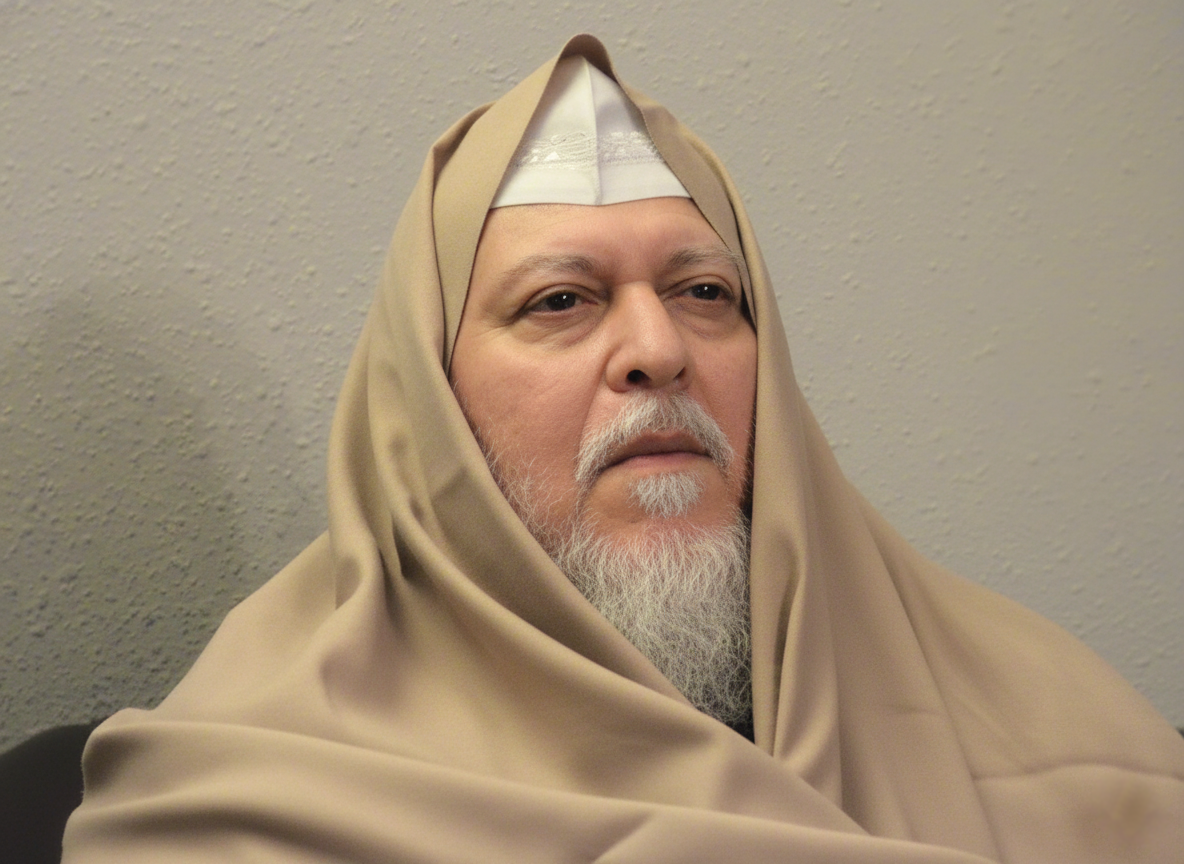Early Life and Family Background
Hazrat Baba Shah Mehmood Yousufi (ra) was born on January 10, 1944 (14th Muharram 1363 AH), on a Monday, in Kamayut, Burma (present-day Myanmar). His family was distinguished not only for its wealth and learning but also for its spiritual heritage. His honorable father, Mohammad Jaffar Sherazee (ra), and grandfather, Agha Mahmood Sherazee (ra), belonged to a respected family from Shiraz, Iran.
Note: For a more detailed biography, please visit his Comprehensive Biography available only to Silsila Members (login required). Or download the Chronicles of a Dervish PDF.
His lineage traces back to Hazrat Safiuddin Abul Fatah Ishaq Ardabili (ra), famously known as “Sheikh Ardabili (ra).” He was the seventh descendant of Firuz-Shah Zarriñ Kolah (ra) and was connected with the Qadri and Safavi Sufi orders.
Spiritual Lineage and Chains of Connection
Sarkar Baba Sahib’s spiritual lineage connects through three distinct and sacred chains that ultimately lead back to our Beloved Prophet Muhammad (saw).
- Qadri Order — Connection through Hazrat Sheikh Abdul Qadir Jilani (ra), also known as Ghous-ul-Azam.
- Chishti Order — Affiliation with Hazrat Moinuddin Chishti (ra), Khwaja Ghareeb Nawaz.
- Owaisi Order — Spiritual link with Hazrat Awais Qarani (ra).
Family Migration and Birth Beneath the Tree of Maryam
During the Safavid era, when Shah Ismail declared Shia as the state creed, the family of Sheikh Ardabili (ra) migrated in various directions to preserve their Sunni faith.
In the Shan province of Burma, the local king welcomed them with great honor. Their trade prospered, but during World War II, circumstances worsened. The family decided to migrate to Calcutta (India). While waiting at the port for a ship, Sarkar’s respected mother, Bibi Sahiba (raا), began to experience labor pains. She was rested beneath a tree — known as the “Tree of Maryam.” Under its blessed shade, by the Grace of Allah (swt), Hazrat Baba Shah Mehmood Yousufi (ra) was born.
Childhood and Upbringing
At the time of his father’s passing, he was only three years old. Before departing, his father advised his wife, Bibi Sahiba (raا), to marry his close friend, Manzur-ul-Haq Rehmani Sahib (ra). She followed his counsel. Captain Manzur-ul-Haq Rehmani Sahib (ra), who served with Pakistan International Airlines, raised Sarkar with more love, care, and education than one gives to their own child.
His education began in Dhaka and was completed in Rawalpindi. He secured first position in matriculation from Sir Syed School and then pursued higher studies at Gordon College. In July 1993, the University of Karachi and Dar-ul-Irfan jointly conferred upon him an honorary Doctorate in Spiritual Philosophy.
Beginning of the Spiritual Journey
He inherited the love for spirituality from his father, who was a disciple of Hazrat Sufi Muhammad Farooq Rehmani (ra) (also known as Pir Farooq or Pandit Farooq Sahib). His father’s spiritual brother, Hazrat Aarif Rehmani (ra) (Bhaijaan Qibla ra), would often stay in Rawalpindi and reside in Sarkar’s room.
Bhaijaan Qibla’s love was such that his absence caused deep restlessness. One day at the airport, when Sarkar’s gaze fell upon Bhaijaan Qibla, a state of ecstasy overtook him. Poet Ahmed Faraz, who was present nearby, expressed the moment in verse:
“Ye Aalam Shauq Ka Dekha Na Jaaey
Vo But Hai Ya Khuda Dekha Na Jaaey”
(This state of passion cannot be witnessed,
Whether that is an idol or the Divine, cannot be discerned.)
This moment mirrored the intensity of divine love and ecstasy. Once, while many were waiting in line for initiation, Sarkar also stood among them. Bhaijaan Qibla smiled and said: “Not yet, Dear! Your name isn’t written in my book. I’m only your private tutor. Your matter lies elsewhere — you’ll recognize him when he arrives.”
Hearing this, Sarkar remained silent, but a deep certainty arose in his heart that the “True Sheikh” would soon appear.
Spiritual Experiences at Bari Imam (ra)
Near Rawalpindi, at Noorpur Shahan (present-day Islamabad), the shrine of Hazrat Bari Imam (ra) became a turning point in his spiritual life. In his youth, he often cycled there and spent hours in meditation. The custodian of the shrine and his wife held great affection for him and would often insist that he join them for meals.
The dervishes at the shrine called him “Divine Light of His Eyes.” The custodian once said:
“He is beloved to Bari Imam (ra); the chosen of the Great Shah.”
One day, he saw a tall, radiant figure continuously reciting this Persian couplet:
Persian: “Dar Jawani Tauba Kardan, Shevaey Payambari.”
Meaning: “Itʼs the Tradition of Holy Messengers, To Seek Repentance at a Youthful Age”
He asked the custodian, “Do you see this person?” The custodian replied, “No, we see no one.” When he looked again, the figure vanished before everyone’s eyes. The mystery was unveiled later when that very same being appeared at his home as a “special guest.”
The Arrival of a Special Guest
One day, while Sarkar and Bhaijaan Qibla (ra) were at their home in Satellite Town, Rawalpindi, there was a knock at the door. Sarkar opened it to find the same tall figure from Bari Imam’s shrine standing there.
He asked, “Is Arif Miañ here?”
Sarkar replied, “Who shall I say is asking?”
The visitor answered, “Tell him, we have come.”
When Sarkar relayed this message, Bhaijaan Qibla immediately dropped his rosary and rushed barefoot to the door. He respectfully placed his hands at the visitor’s feet and stood in reverence. The family was astonished — who could this majestic person be, before whom even such a noble Sheikh displayed such humility and yearning?
Stages of Initiation and Training
The visitor was none other than Hazrat Kañwar Asghar Ali Khañ Sahib (ra), also known as Hazrat Baba Albeyle Shah Yousufi (ra) — one whose slightest gesture governs the system of spirituality itself.
Around 1960, Sarkar Baba Sahib and his family moved from Rawalpindi to Karachi, where the key events of his spiritual journey unfolded.
On January 12, 1973 (6th Dhul-Hijjah 1396 AH), Bhaijaan Qibla (ra) passed away, having fulfilled his role as Sarkar’s personal teacher. After his passing, Sarkar fell into deep silence and melancholy. Concerned, Bibi Sahiba (raا) sought advice from a friend and visited Hazrat Baba Zaheen Shah Taji (ra). At the end of their meeting, he said, “Send him to me. Let’s see if this faqir can help.” A few days later, during his first visit to the Khanqah-e-Tajiyah at Mewa Shah, he spent 11–12 hours in the presence.
From then on, daily visits began. Witnessing Sarkar Aala Hazrat (ra) coming and going filled his heart with deep connection. He recalled Bhaijaan Qibla’s words and silently recognized Hazrat Zaheen Shah Baba (ra) as his beloved Sheikh. It became clear in the gatherings that Sarkar Aala Hazrat (ra) did not accept disciples directly, indicating that Bayʼat through Hazrat Zaheen Shah Baba (ra) was sufficient.
Thus, during the Eid celebrations — likely on March 7, 1962 — while the Qawwali verse was being sung: “Eid Gaah-e-Ma Gharibaañ Kuw-e-To, Inbisaat-e-Eid Deedan Ruw-e-To” (“Place of Eid for Us Poor is Your Lane, Eid Occurs When We Gaze Upon Your Face”) — Sarkar Baba Sahib took Bayʼat (spiritual pledge) at the blessed hands of Hazrat Zaheen Shah Baba (ra).
Chilla Shareef (Spiritual Seclusion)
Under the guidance of Sarkar Aala Hazrat (ra), Hazrat Zaheen Shah Taji (ra) prescribed a spiritual retreat (Chilla) for further advancement. This was held in the Buffer Zone (then an uninhabited area) on the land purchased for Khanqah-e-Yousufiyah Tajiyah — the same site where Taj-ul-Masajid stands today.
During the Chilla, alongside many sacred invocations, the practice of “Shughal-e-Shamsi” was also performed — a spiritual exercise involving the remembrance of the Divine Names of Allah (swt) in a specific sequence.
Humility and Love
Even after being granted permission to take disciples, Sarkar Baba Sahib would accept Bayʼat only to bring seekers into the order, not for personal followers. Although authorized to sign and issue Guldasta Shareef (initiation certificates), he would send people to Hazrat Zaheen Shah Baba (ra), insisting they regard him as their Sheikh. As Sarkar Baba Sahib would say, “My role is only to bring people into the Silsila (spiritual order).”
He lived in a perpetual state of “Kun Fayakun” (Be! and it is). Later, he traveled from Karachi toward Punjab, spreading the teachings of the order — from Lahore to Northern and Southern Punjab — advocating love, respect for humanity, and the propagation of Yousufi teachings.
Albeli Yousufi Coronation
In 1981, a special spiritual ceremony took place. While the family celebrated a birthday in the garden, an inner gathering was held inside with Sheikhs of various orders, saints, and successors present. After Quran recitation, Fatiha, and Salam, Sarkar Aala Hazrat (ra) proclaimed a decisive statement:
“From now on, you no longer need anyone as an intermediary to come to me.”
Services to the Silsila
In 1980, the foundation of Taj Nagri was laid. Those were blessed times — every corner of Karachi resonated with Zikr and Sama‘; gatherings of the 26th Shareef drew devotees from near and far, and the lamps of Yousufi connection shone brightly throughout the city.
After Taj Nagri, the expanding spiritual blessings directed the path toward North America. On November 17, 1986, the family migrated to New York. From there, Urs and Fatiha gatherings continued regularly. Numerous American and Canadian seekers were drawn into the Yousufi order; circles of remembrance and Sama‘ were formed, and the Khanqah system expanded with modern means.
Eventually, this expansion found its central home in Houston, Texas. Sarkar Baba Sahib announced:
“We are moving to Houston — whoever can come, should join us.”
Many disciples settled nearby. Weekly and annual gatherings, online sessions, and personal guidance continued to flow, keeping the blessings alive.
In his gatherings, Sarkar often expressed states of the heart through select Persian and Urdu poetry — drawing wisdom from Sheikh Saadi’s Gulistan and Jami’s verses of servanthood:
“Ta Daagh-e-Ghulamiy-e-To Daar-Aeym,
Har Ja Keh Rav-Aeym Baadshah-Aeym.”
(As Long as We Bear the Mark of His Servitude,
We Remain Kingly Wherever We Go.)
This reflected his inner state. His method of teaching was gentle and compassionate, yet firmly rooted in principle — emphasizing respect for the saints, adherence to Sunnah, and illumination through the Book and remembrance. This was his message.
Ultimately, his life reflected the Divine touch of “Kun Fayakun,” the acceptance of prayer, and the nurturing of hearts — all unified under reverence for the Sheikh and love for the saints. Whoever came to this threshold received blessings according to their capacity, and to this day, that grace continues — like a prayer whose acceptance lies in sincerity. This Chronicles of a Dervish stands as a living testament to that sincerity and connection, guiding generations through its enduring light. For a detailed account of Sarkar Baba Sahib’s life, read Chronicles of a Dervish.


